122P/de Vico = P/1995 S1
Wide-field CCD observations of this comet in late September 1995 exhibit intensive plasma-tail activity. A number of frames shows the comet prominent ion tail with clouds and knots of material as well as some disconnections. At that time, the tail length reached at least 7 deg. By the end of October the comet faded but still expressed conspicious ion tail activity. Late-November observations shows that the comet faded to mag. 8-9 and the plasma tail discontinued. However, there was still some tail activity visible on R -band images. By the end of January 1996, the comet faded to mag. ~15.
Images are all JPEG files. The orientation is North at the top, East to the left.
September 24, 1995
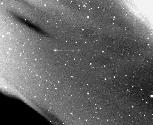 26K
26K
The first image of comet 122P/de Vico was taken from the Crni Vrh Observatory
in the dawn of 1995 Sep. 24. The weather conditions were rather poor that
morning with some clouds over the horizon. Anyway, the comet is well visible
with about 2 deg of tail on this 30s wide-field unfiltered image, obtained
with 90mm, f/4 lens and CCD. Exposure started at 3:36:11UT.
September 26, 1995
 30K
30K
Wide-field, unfiltered image, taken with the 180mm, f/5.6 lens and
CCD (field 3.8 x 2.6deg). Exposure time was 120s, starting at 3:25:14UT.
Prominent ion tail with disconnection at nucleus distance ~1.7-2.1deg is
clearly visible.
 23K
23K
Another 180s, V filter image was obtained with the 20-cm, f/2 Baker-Schmidt
camera and ST-6 CCD. Exposure started at 3:24:58UT.
Notice !
Because the comet was low over the horizon, the dawn often affected observations. To avoid large variations in sky gradient over the frame, the SKYSUB procedure has been used at images taken on Sep. 27 and later. It calculates the linear best-fit sky value and subtracts it from the frame.September 27, 1995
 53K
53K
Wide-field unfiltered mosaic image was taken on 1995 Sep. 27 with the
180mm, f/5.6 lens and CCD. The head region was exposed for 120s, starting
at 3:16:40UT. The end of tail region was exposed for 180s, starting at
3:25:55UT. The comet ion tail may be traced up to 6.3 deg from the comet
nucleus.
 20K
20K
V-filter Image, obtained on 1995 Sep. 27 with the 20-cm, f/2 Baker-Schmidt
camera and ST-6 CCD. Exposure time was 180s, starting at 3:17:51UT.
 20K
20K
R-filter Image, obtained on 1995 Sep. 27 with the 20-cm, f/2 Baker-Schmidt
camera and ST-6 CCD. Exposure time was 120s, starting at 3:35:24UT.
September 30, 1995
 45K
45K
Wide-field unfiltered mosaic image, taken on 1995 Sep. 30 with the
180mm, f/5.6 lens and CCD. The left exposure started at 2:58:50UT and the
right one at 3:03:44UT. Both had the exposure duration of 120s. The comet
ion tail may be traced up to ~6 deg from the comet nucleus. A distinct
cloud of material is present 1.8 deg from the nucleus. Furthermore, two
very conspicious rays are extending from the main ion tail stream. R Leonis
is the brightest star in the field.
October 1, 1995
 54K
54K
Mosaic of two 120s wide-field unfiltered images was taken on 1995 Oct.
1 with the 180mm, f/5.6 lens and CCD. The left exposure started at 3:09:18UT,
and the right one at 3:15:40UT. The comet ion tail may be traced up to
~6.6deg. There is a narrow stream of fresh plasma extending for ~2.1deg
from the nucleus. The whole ion tail shows a number of interesting features.
Prominent spike (probably dust) extends from the coma region ~0.5deg in
PA~290deg.
 29K
29K
An excellent mosaic of two 180s exposures was taken on 1995 Oct. 1
with the 20-cm, f/2 Baker-Schmidt camera, ST-6 CCD and V filter. The central
time of both exposures was 3:18UT.
 38K
38K
False-color version of the previous image.
Image of 122P/de Vico taken on Oct. 2, 1995 by Igor Grom at Krvavec (alt. 1745m)
 54K
54K
False-color image taken on 1995 Oct. 2.141UT (start) with the 3.2/200mm
lens and T-Max-400 film. Exposure time was 7 minutes. The tail length on
this image is about 6o. Copyright (c) 1995 Igor Grom.
October 14, 1995
 31K
31K
This 120s V-filter image of comet was taken in moonlight conditions
on 1995 Oct. 14 with the 19-cm, f/4 flat-field S-C and CCD. Exposure started
at 3:59:58UT.
October 25, 1995
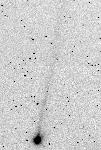 42K
42K
Mosaic of two 120s R-filter images was taken on 1995 Oct. 25 with the
19-cm, f/4 flat-field S-C and CCD. The head region exposure started at
4:06:06UT and the rest of tail at 4:09:47UT.
October 27, 1995
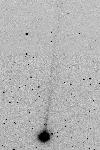 20K
20K
Mosaic of two 120s exposures was obtained on 1995 Oct. 27 with the
20-cm, f/2 Baker-Schmidt camera, ST-6 CCD and V filter. The left image
started at 3:18:16UT and the right one at 3:25:21UT.
 27K
27K
See a false-color version of the previous image.
November 18, 1995
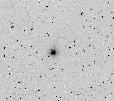 15K
15K
V-filter image, obtained on the evening of 1995 Nov. 18 with the 20-cm,
f/2 Baker-Schmidt camera and ST-6 CCD. Exposure time was 300s , starting
at 17:19:44UT.
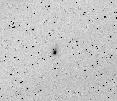 17K
17K
R-filter image, obtained on the evening of 1995 Nov. 18 with the 20-cm,
f/2 Baker-Schmidt camera and ST-6 CCD. Exposure time was 180s , starting
at 17:28:15UT.
November 20, 1995
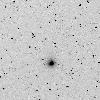 12K
12K
V-filter image, taken on 1995 Nov. 20, with the 20-cm, f/2 Baker-Schmidt
camera and ST-6 CCD. Exposure time was 300s, starting at 17:16:26UT.
 11K
11K
R-filter image, taken on 1995 Nov. 20, with the 20-cm, f/2 Baker-Schmidt
camera and ST-6 CCD. Exposure time was 180s, starting at 17:30:58UT.
November 24, 1995
 12K
12K
V-filter image, taken on 1995 Nov. 24, with the 20-cm, f/2 Baker-Schmidt
camera and ST-6 CCD. Exposure time was 300s, starting at 17:16:26UT.
 12K
12K
R-filter image, taken on 1995 Nov. 24, with the 20-cm, f/2 Baker-Schmidt
camera and ST-6 CCD. Exposure time was 180s, starting at 17:30:58UT.
January 18, 1996
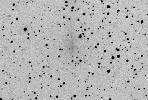 21K
21K
Some thin cirruss clouds were moving accross the field when this faint
image was taken on 1996 Jan. 18, with the 36-cm, f/6.8 S-C telescope, CCD
and V filter. Exposure time was 300s, starting at 4:37:35UT.